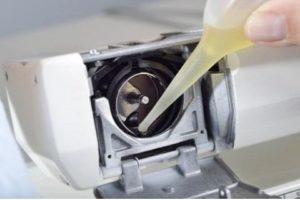
It’s a simple formula: the longevity and performance of your sewing machine are directly proportional to the cleaning and lubrication routine you follow.
The more you take care of your sewing machine’s needs, the better it will perform and the longer it will last.
In this article, we will explain the process of oiling a sewing machine to show you how to do it at home on your own. Just make sure to clean it properly before lubricating it.
Also, lubricate the unit with proper sewing machine oil to avoid issues like contamination or gum-up.
Here’s what you need to do.
Table of Contents
Cleaning the Sewing Machine
It is necessary to clean your sewing machine before oiling. Otherwise, the lubricant will mix with the debris and clog parts of your sewing machine.
As a result, the sewing machine will not run smoothly and make ugly noises.
Cleaning your sewing machine is easy. The process involves a few tools and easy steps.
Make sure you have a dust cleaner, soft fabric, a stiff brush – lint brush, toothbrush or a mascara wand – with you.
Steps Included
You can clean the sewing machine in just a few steps.
- Unplug the machine.
- Remove all those parts of the machine that could become a hindrance, such as stitching plates, needles, bobbin cases, hooks and excess thread.
- Brush away the lint and dust from all the nooks and crannies of your machine using a stiff brush. Clean the bobbin case and area surrounding it, needle plate and in-between the feed dogs. You can use a tweezer to access hard-to-access areas or use compressed air. If you’re using compressed air, make sure to hold the can approximately 4-inches far and at a shallow angle to blow the dirt out of the machine instead of driving it deeper into it.
- Clean larger surfaces of the machine using a dust cleaner or a soft fabric. Use a damp cloth or soapy towel to clean stubborn dirt marks. Completely dry the parts afterwards.
Oiling the Machine
Now that you have thoroughly cleaned the machine, it is ready for oiling.
Remember, car oil or oil used for household purposes isn’t suitable for this task. We would strictly advise you to either use sewing machine oil or the one recommended in the manual.
- Put only a few drops in the moving parts of the machine. For instance, pour a couple of droplets of oil in the resting place of the bobbin case, inside the hook race and around the outer ring of the bobbin hook.
- If you don’t know which parts need lubrication, just turn the handwheel and see which parts rub against each other and create friction. Pour some drops on those parts to reduce friction and wear and tear. Oiling will allow the machine to run smoothly and quietly.
- Manually move those components a couple of times to evenly distribute the oil.
- Refrain from pouring a generous amount of oil as it might get clogged and slow down the motion of the parts.
- Try not to drop oil on those parts of the machine that come in contact with the fabric to avoid staining the garment during sewing. Use muslin or a dry cloth to absorb excess oil.
- You should wipe the machine a couple of times with a damp or soapy cloth to cleans remnants of oil from all parts.
- Now, it is time to put all the disassembled parts back into place.
- Plug the machine. Do a couple of test seams on scrap fabric to see if there’s any oil remnant left in the machine.
How Often to Oil the Sewing Machine
There’s no strict timetable for the oiling of a sewing machine. The frequency of how often should you oil the sewing machine depends on two variables.
1). How frequently do you use the sewing machine.
2). What kind of fabric do you mostly sew with it.
If you’re an occasional or a moderate user, then you should clean and oil your sewing machine once every few months. Conversely, if you use it for a couple of hours daily or weekly, then carry out the process weekly.
Similarly, if you frequently sew heavier fabrics that shed, such as velvet, then follow a more regular and frequent cleaning and oiling routine. In the case of occasional sewing of lighter materials, oiling once a month or every three months is a good idea.
Some Useful Tips
Here are a few tips that will make the job easier.
- If the manual of your machine states lubrication-free, then don’t bother yourself at all. Conversely, if your sewing machine does require lubrication, consult the instructional manual to see which parts need oiling.
- Do not disassemble all the parts of your sewing machine at once. If you do that, putting them might back become complicated. You could even lose a few components during the process.
- The second you hear squeaking and notice dust buildup, know that it is time to show a little care for your machine.
- Keep your sewing machine well-covered when not in use to prevent dust buildup.
Conclusion
A little care on a regular basis will enhance the performance and lifespan of your sewing machine and keep it from making unpleasant noise.
Oiling your sewing machine frequently will keep it functional for ages.
But, make sure to clean it first to avoid contamination.
This article must have helped you understand how to lubricate your sewing machine.
You can also take help from the machine’s manual or online sources to do the job.